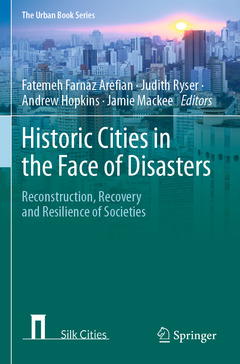Historic Cities in the Face of Disasters, 1st ed. 2021 Reconstruction, Recovery and Resilience of Societies The Urban Book Series

This book examines reconstruction and resilience of historic cities and societies from multiple disciplinary and complementary perspectives and, by doing so, it helps researchers and practitioners alike, among them reconstruction managers, urban governance and professionals. The book builds on carefully selected and updated papers accepted for the 2019 Silk Cities international conference on ?reconstruction, recovery and resilience of historic cities and societies?, the third Silk Cities conference held in L?Aquila, Italy, 10-12 July 2019, working with University of L?Aquila and UCL.
This multi-scale, and multidisciplinary book offers cross-sectoral and complimentary voices from multiple stakeholders, including academia, urban governance, NGOs and local populations. It examines post-disaster reconstruction strategies and case studies from Europe, Asia and Latin America that provide a valuable collection for anyone who would like to get a global overview on the subject matter. It thereby enables a deeper understanding of challenges, opportunities and approaches in dealing with historic cities facing disasters at various geographical scales. Additionally, it brings together historical approaches to the reconstruction of historical cities and those of more recent times. Thus, it can be used as a reference book for global understanding of the subject matter.
Dr. Fatemeh Farnaz Arefian is an interdisciplinary expert in development planning, urban design, and architecture. She combines academic research and education with extensive practice-based experience in the Middle East, UK, and Southeast Asia.
As a private sector consultancy director, her first-hand encounter with disasters in the historic city of Bam motivated her to return to academia and pursue her multidisciplinary Ph.D. research and further academic activities at the Bartlett Development Planning Unit (DPU), University College London (UCL), where she is also associated with. She is the founding director of Silk Cities initiative on contextual contemporary challenges cities in countries along the historic Silk Roads face within the process of urban transformations. She is an invited speaker for international conferences and workshops. Her industry experience in post-disaster reconstruction has been featured in a guidance for humanitarian organisations. Farnaz has published academic and professional books and papers, such as Urban Heritage Along the Silk Roads (Springer 2020), Organising Post-Disaster Reconstruction Processes (Springer 2018), and Urban Change in Iran (Springer 2016). The latest publication Farnaz currently leads on is Historic Cities in the Face of Disasters. Her past knowledge exchange activities received special attention from UNESCO Director General.
Judith Ryser qualified architect and urbanist with a social sciences MSc, Judith’s cosmopolitan professional life in London, Paris, Berlin, Geneva (United Nations), Stockholm and Madrid is focusing on built environment sustainability and researching, reviewing, writing on cities in the knowledge society. She is a life member of ISOCARP (International Society of City and Regional Planners), ex-Vice President, General Rapporteur of the 50th anniversary congress 2015, editor and writer of several publications (e.g. "ISOCARP, 50 Years of Knowledge Creat
Offers multi-perspective examination on this complex subject matter
Offers new perspectives that sets new directions for practice and research
Addresses post-disaster reconstruction strategies and case studies from the Europe, Middle East, Asia and Latin America
Provides a valuable collection and reference book
Helps researchers and practitioners alike
Date de parution : 09-2022
Ouvrage de 666 p.
15.5x23.5 cm
Date de parution : 09-2021
Ouvrage de 666 p.
15.5x23.5 cm



